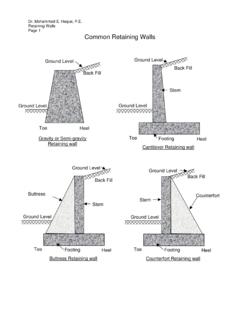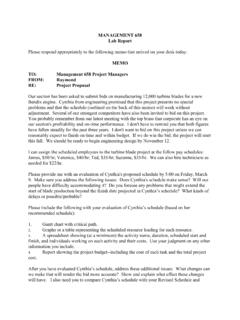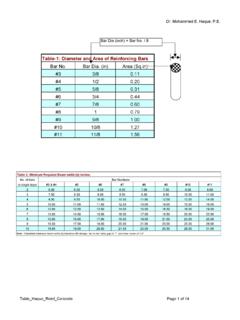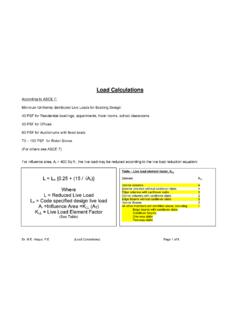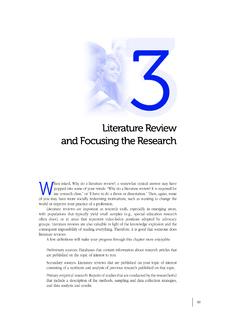Transcription of Literature Reviews Purpose of the Literature Review
1 Literature Reviews Purpose of the Literature Review Literature Reviews , as their name suggests, explain or briefly describe the work that has been reported on a topic or field. Literature Reviews form a central component of research reports and technical articles for an important reason: the research you report should fill (or help fill) a gap in what is known about a topic. Thus, after you introduce your topic to your readers in the report introduction, you will usually proceed to Review or describe the relevant research on the topic. Your focus: to show that your research fills a gap and how your research fits within existing studies.
2 In many reports, the Literature Review exists within the introduction and integrates with the report Purpose . Extensive Literature Reviews may be separate from the report introduction and labeled Review of Relevant Research or something like that. The examples here illustrate how the Literature Review occurs within the introduction. Note that the examples are color coded to help you see essential parts of the Literature Reviews . In this discussion, you will find seven examples. Study several of these (as many as you believe you need), then move to the end of the document to find a procedure for planning and developing the Literature Review .
3 Example one Behavioral Health Data Report: Behavioral Health Measures Across Medicaid Managed Care Plans and Models-- illustrates this merger of the report Purpose and the supporting Literature Review . Notice that this report begins with the Purpose statement, which is justified by a Review of pertinent programs. Section 2 explains the rationale for the program measurements selected. Section 3 explains how the information in the report will be used, which supplements the original report Purpose statement.. Note, in this example, documents discussed either appear as links in the text or as URL footnotes, which can be accessed if the reader wishes to do so.
4 This example shows how the report Purpose , the Literature that supports that Purpose , and the report s intended use combine to prepare readers for the main body of the report that follows: INTRODUCTION Why is the State publishing this information? The central goal of this project is to collect and analyze behavioral health (mental health and chemical dependency) data across the Medicaid managed care programs (STAR1, STAR+PLUS2, NorthSTAR3 and PCCM4). Previous research and recent legislation have pointed to the need to more closely evaluate and regularly publish key behavioral health measures. In December 2002, the Health and Human Services Commission (HHSC) published a legislatively mandated report, Behavioral Health in Managed Care: A Review of Texas Medicaid Models5.
5 The report noted that the only Medicaid managed care model to regularly publish behavioral health performance measures is the NorthSTAR model, via the program s quarterly data book. One of the Report s main recommendations was that the State identify, collect and publish key behavioral health measures for Medicaid managed care to assist the State in program monitoring and improvement. This effort is a direct outgrowth of that recommendation. Additionally, SB 1182 (78th Legislature, Regular Session) requires HHSC to regularly monitor behavioral health services within the Medicaid managed care program. Regular publication and analysis of data related to these services is a key component of HHSC s plan to fulfill this legislative mandate.
6 Lastly, recent research has shown that while treatment and management of many health conditions has improved, treatment of behavioral health conditions remain a critical shortcoming in the health care system. The State of Health Care Quality 20036 by the National Committee for Quality Assurance (NCQA) reported that mental health conditions are a notable exception to the trend toward improvement in health plan performance and treatment. By regularly publishing behavioral health measures, HHSC intends to increase the level of transparency and accountability for Medicaid managed care behavioral health services. HHSC believes that this effort to measure and report key behavioral health measures is a necessary first step toward meaningful quality improvement.
7 Why did the State choose these measures? These measures were chosen because they provide data that can be used to evaluate the performance of the various program models and individual health plans and therefore can be a tool to improve behavioral health care within Medicaid managed care. Research has shown that some data indicators are early warning signs of potential problems within a managed care For example, high readmission rates to inpatient psychiatric or substance abuse care may indicate an inappropriate discharge decision and / or the absence of adequate community services. During this initial analysis of behavioral health measures across multiple managed care models, the State chose a limited set of available measures which are likely to indicate potential problems.
8 Some of these measures were created by the State to evaluate utilization or quality. Other measures were taken from nationally used performance measurement tools, such as the Health Plan Employer Data Information Set (HEDIS). HEDIS is a set of standardized performance measures created to allow purchasers and consumers to compare the performance of managed care plans. While HEDIS has some limitations (for example, use of HEDIS specifications allows comparison to national benchmarks, but may not always accommodate the nuances of a particular program), it is generally considered the industry standard for performance measurement. A benefit of HEDIS data is that it allows for comparison of Texas data with national benchmarks, so that plan performance can be compared against a consistent and meaningful yardstick.
9 Readers will note that in many of the measures, a HEDIS mean is reported as a benchmark. The HEDIS mean is derived from data that Medicaid managed care plans across the country submit to the National Committee on Quality Assurance s (NCQA) HEDIS project. For comparison purposes, the Medicaid managed care plans results are shown at the 50th percentile and are labeled HEDIS mean. What will the State do with this information? The State will use this information to monitor behavioral health services and make improvements where data show potential problems at the health plan level, or across programs. Where deficiencies are identified, the State will work closely with the health plans to make program improvements.
10 The State will monitor these measures over time to determine their usefulness in program evaluation and improvement. Some measures may ultimately be revised, or new measures added. _____ 1 #1 2 3 4 5 6 7 Substance Abuse and Mental Health Services Administration (SAMHSA). Implementing an Early Warning System: A Manual for State Evaluation of Medicaid Behavioral Health Managed Care. Rockville, Maryland: Department of Health and Human Services; 2002. Example 2--The Everyday Problems of Working Parents: Implications for New Technologies, a study conducted by Hewlett-Packard, also illustrates the close relationship between the Purpose of the report and existing research.




